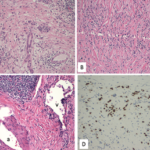As in this case, it can be difficult to initially distinguish between IgG4-related disease and ANCA-associated vasculitis. Increased numbers of IgG4-positive plasma cells in an orbital biopsy alone are not sufficient to distinguish IgG4-related disease from GPA.10 Other histopathologic features of IgG4-related disease include storiform fibrosis, dense lymphoplasmacytic infiltrates and the relative paucity of necrosis and acute inflammation. These can be helpful in distinguishing IgG4-related disease of the eye from orbital GPA. Due to the above factors, as well as the presentation and laboratory findings, our patient was subsequently diagnosed with GPA instead of IgG4-related disease.
Historically, orbital involvement with GPA has been associated with a more difficult course, often including refractory disease.11,12 Interestingly, the more refractory courses have been associated, at least in adults, with anti-proteinase 3 positive antibody. These cases have even been known to lead to visual loss and other sequela of long-standing disease. Luckily, children with ocular GPA have responded well to treatment with high-dose glucocorticoids and rituximab.13 This response is also being seen in our patient.
 Geoffrey E. Thiele, MD, is a second-year pediatric rheumatology fellow at Children’s Hospital of Los Angeles. He attended the University of Nebraska Medical Center College of Medicine, Omaha, and completed his residency at Phoenix Children’s Hospital, both of which cemented his interest in the field of pediatric rheumatology.
Geoffrey E. Thiele, MD, is a second-year pediatric rheumatology fellow at Children’s Hospital of Los Angeles. He attended the University of Nebraska Medical Center College of Medicine, Omaha, and completed his residency at Phoenix Children’s Hospital, both of which cemented his interest in the field of pediatric rheumatology.
 Sara Haro, MD, is a pediatric rheumatologist practicing at Children’s Hospital Los Angeles. Her clinical interests include juvenile idiopathic arthritis and musculoskeletal ultrasound.
Sara Haro, MD, is a pediatric rheumatologist practicing at Children’s Hospital Los Angeles. Her clinical interests include juvenile idiopathic arthritis and musculoskeletal ultrasound.
References
- Garlapati P, Qurie A. Granulomatosis with polyangiitis in: StatPearls. Treasure Island (Fla.): StatPearls Publishing; 2022 Jan. https://www.ncbi.nlm.nih.gov/books/NBK557827.
- Schirmer JH, Wright MN, Herrmann K, et al. Myeloperoxidase-antineutrophil cytoplasmic antibody (ANCA)-positive granulomatosis with polyangiitis (Wegener’s) is a clinically distinct subset of ANCA-associated vasculitis: A retrospective analysis of 315 patients from a German vasculitis referral center. Arthritis Rheumatol. 2016 Dec;68(12):2953–2963.
- Boulter EL, Eleftheriou D, Sebire NJ, et al. Inflammatory lesions of the orbit: A single paediatric rheumatology centre experience. Rheumatology (Oxford). 2012 Jun;51(6):1070–1075.
- Belanger C, Zhang KS, Reddy AK, et al. Inflammatory disorders of the orbit in childhood: A case series. Am J Ophthalmol. 2010 Oct;150(4):460–463.
- Vischio JA, McCrary CT. Orbital Wegener’s granulomatosis: A case report and review of the literature. Clin Rheumatol. 2008 Oct;27(10):1333–1336.
- Wardyn KA, Ycińska K, Matuszkiewicz-Rowińska J, Chipczyńska M. Pseudotumour orbitae as the initial manifestation in Wegener’s granulomatosis in a 7-year-old girl. Clin Rheumatol. 2003 Dec;22(6):472–474.
- Chipczyńska B, Grałek M, Hautz W, et al. Orbital tumor as an initial manifestation of Wegener’s granulomatosis in children: A series of four cases. Med Sci Monit. 2009 Aug;15(8):CS135–CS138.
- Drobysheva A, Fuller J, Pfeifer CM, Rakheja D. Orbital granulomatosis with polyangiitis mimicking IgG4-related disease in a 12-year-old male. Int J Surg Pathol. 2018 Aug;26(5):453–458.
- Ahmed M, Niffenegger JH, Jakobiec FA, et al. Diagnosis of limited ophthalmic Wegener granulomatosis: Distinctive pathologic features with ANCA test confirmation. Int Ophthalmol. 2008 Feb;28(1):35–46.
- Deshpande V, Zen Y, Chan JK, et al. Consensus statement on the pathology of IgG4-related disease. Mod Pathol. 2012 Sep;25(9):1181–1192.
- Durel CA, Hot A, Trefond L, et al. Orbital mass in ANCA-associated vasculitides: Data on clinical, biological, radiological and histological presentation, therapeutic management, and outcome from 59 patients. Rheumatology (Oxford). 2019 Sep 1;58(9):1565–1573.
- Berti A, Kronbichler A. Orbital masses in ANCA-associated vasculitis: An unsolved challenge? Rheumatology (Oxford). 2019 Sep 1;58(9):1520–1522.
- Riancho-Zarrabeitia L, Peiró Callizo E, Drake-Pérez M, et al. Granulomatosis with polyangiitis with isolated orbital involvement in children: A case report successfully treated with Rituximab and review of literature. Acta Reumatol Port. 2019 Jul 8;44( Jul-Sep (3)):258–263.


